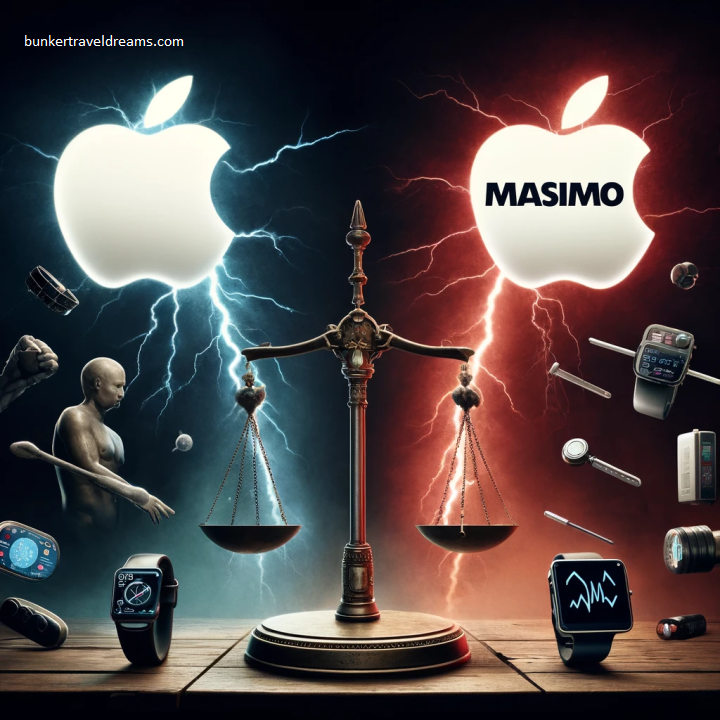Introduction
Apple vs Masimo are involved in a long-running patent dispute over Apple’s blood oxygen measurement technology. Masimo is renowned within the medical community for its pulse oximetry technology. The dispute started when Masimo accused Apple (Apple vs Masimo) of poaching its employees and stealing its pulse oximetry technology in the guise of partnership, resulting in a lawsuit over 12 patents, which ended in a mistrial. Apple (Apple vs Masimo)claims that Masimo copied Apple Watch features to use in its smartwatches. Masimo is not a small guy in the tech world; it is an established billion-dollar company with a well-known track record and good products.
What happened between Apple vs Masimo?
The tech giant countersued Masimo for patent infringement in 2022, alleging that Masimo copied Apple Watch features to use in its smartwatches.
history of Apple vs masimo
The Apple vs. Masimo dispute is a legal battle over patents for blood oxygen monitoring technology in Apple Watches. The dispute began in 2020 when Masimo, a medical technology company, sued Apple for patent infringement.
Apple vs Masimo Timeline
January 2020: Masimo files a lawsuit against Apple in the Central District of California
2020: Apple introduces pulse oximetry in the Series 6 Watch
ITC ban: The US International Trade Commission (ITC) bans the Series 9 and Ultra 2 models of the Apple Watch
Federal appeals court: The federal appeals court pauses the ban, but reinstates it in January 2024
Apple redesigns the watches: Apple removes blood oxygen features from the Series 9 and Ultra 2 watches
The Genesis of the Conflict
The story dates back to 2013, when Masimo revolutionized the medtech industry with a groundbreaking solution for accurate blood oxygen measurements. Apple, in the early stages of building its wearables business, sought to integrate Masimo’s technology into its products. However, what began as a potential partnership turned into a nightmare for Masimo as Apple allegedly poached key employees and started filing patents without Masimo’s knowledge.
Masimo’s ITC complaint
Masimo, a medical technology company, filed an ITC complaint against Apple in August 2021. The complaint alleged that Apple infringed on Masimo’s patents for pulse oximetry technology in Apple Watches. The U.S. International Trade Commission (ITC) ruled in favor of Masimo, issuing a limited exclusion order in October 2023.
Apple’s complaint against the masimo (Apple vs Masimo)
Apple sued Masimo for patent infringement in 2022, claiming that Masimo’s smartwatches copied Apple Watch features. The case centered on Masimo’s W1 and Freedom smartwatches and their chargers.
What Apple alleged (Apple vs Masimo)
- Masimo’s smartwatches infringed on Apple’s design patents
- Masimo’s chargers infringed on Apple’s D’131 patent
- Masimo’s actions were deliberate and an attempt to avoid the court
What the jury ruled (Apple vs Masimo)
- Masimo’s earlier W1 and Freedom watches and chargers infringed on Apple’s design patents
- Masimo’s current smartwatch models did not infringe on Apple’s patents
- Apple was awarded $250, the statutory minimum for infringement
What Masimo said (Apple vs Masimo)
- The verdict was a victory for Masimo on the issue of an injunction
- The decision only applied to a discontinued module and charger
- Apple’s patent lawsuit was retaliatory
What Apple said (Apple vs Masimo)
- They were satisfied with the jury’s conclusion that Masimo “wilfully infringed Apple’s patented designs.”
- They emphasized that Masimo “took shortcuts by launching a device that imitates the Apple Watch.”
Implications for Apple vs masimo
The Apple vs. Masimo patent infringement lawsuit has implications for how large corporations navigate intellectual property (IP) rights and compete in the marketplace. The case also highlights the importance of considering the broader context of technology, health, and law.
Implications
IP rights
The case highlights the importance of IP rights for smaller companies and how large corporations can balance legal obligations with market demands.
Competition
The case shows how companies can use legal battles to strengthen their positions and gain competitive advantages.
Innovation
The case demonstrates how companies can navigate innovation and competition without infringing on the rights of others.
Dispute resolution
The case shows how companies can use legal and technical options to resolve disputes.
What happened in the case?
- Apple sued Masimo for patent infringement over design elements in Masimo’s smartwatches.
- A Delaware jury found that Masimo infringed on two of Apple’s patents.
- Apple was awarded $250 in damages, the statutory minimum.
- The jury rejected most of Apple’s claims, including an injunction against Masimo’s current products.
- The US International Trade Commission (ITC) banned imports of certain Apple Watch models.
Apple appealed the ITC’s decision to the US Court of Appeals for the Federal Circuit.
Invention of apple
Steve Jobs, Steve Wozniak, and Ronald Wayne invented the Apple computer in 1976. The first Apple computer, the Apple I, was designed by Wozniak and hand-built in Jobs’s parents’ garage in Los Altos, California.
The Apple I
The Apple I was a single motherboard with a CPU, RAM, and basic video chips.
It was sold as a base kit without a monitor, keyboard, or power supply.
The Apple I was inexpensive and elegant for its time.
It was a shift in personal computing, as it was a fully tested and working board.
Other Apple products (Apple vs Masimo)
Apple II: Introduced in 1977, this computer had an integrated keyboard and case.
Macintosh: Introduced in 1984, this was the first personal computer to use a graphical user interface (GUI) and a mouse.
Apple Lisa: Introduced in 1983, this was the first home computer with a GUI.
IPod: Introduced in 2001, this product revolutionized the music industry.
IPhone: Introduced in 2007, this product changed the way people use phones.
Invention of masimo
Joe Kiani founded Masimo in 1989 and co-invented the Masimo SET® technology. SET® is a non-invasive monitoring technology that revolutionized how clinicians measure pulse oximetry.
Explanation
- Masimo is a medical technology company that develops patient monitoring devices.
- Masimo’s technologies are used to monitor more than 200 million people each year.
- Masimo also develops and manufactures hospital automation and connectivity solutions, telehealth, consumer health, and consumer audio products.
- Masimo has been involved in a patent dispute with Apple over its oximeter features.
Other inventions by Joe Kiani
- Kiani also founded the Patient Safety, Science & Technology Movement.
- Kiani is the Chairman of the Board and Chief Executive Officer of the Masimo Foundation for Ethics, Innovation, and Competition in Healthcare.
Patient and consumer monitoring of apple vs masimo
Apple vs Masimo are both companies that offer patient and consumer monitoring devices. Apple’s devices use built-in sensors and apps, while Masimo’s devices use pulse oximetry technology. The two companies have been involved in a legal battle over the use of pulse oximetry in their devices.
Apple devices
- Collect health and fitness data from the Apple Watch, iPhone, iPad, and compatible third-party devices
- Use the Health app to keep data secure and encrypted
Masimo devices
- Use pulse oximetry technology to monitor oxygen saturation, pulse rate, respiration rate, and more
- Provide noninvasive and continuous monitoring
Legal battle
- Masimo sued Apple in 2020 for infringing on its patents for blood oxygen and heart rate measurement
- The US International Trade Commission (ITC) imposed a ban on the Apple Watch Series 9 and Ultra 2 models
- A federal appeals court paused the ban, but it was reinstated in January
- Apple redesigned the Series 9 and Ultra 2 watches, removing blood oxygen features
The outcome of the legal battle(Apple vs Masimo) could have implications for patent enforcement in wearable health technology.
Conclusion
As the tech world watches this unfolding saga between Apple vs Masimo, it raises critical questions about ethics, corporate behavior, and the power dynamics between industry giants and smaller innovators. The outcome of this legal tussle could set a precedent for future disputes, reminding even the most formidable players that actions have consequences in the complex landscape of intellectual property and innovation.
In October 2024, a Delaware jury ruled in favor of Apple in its patent infringement lawsuit against Masimo. The jury found that Masimo’s older smartwatch designs and chargers infringed on Apple’s design patents. However, the jury also found that Masimo’s current models did not infringe on Apple’s patents.
FAQs
What is the issue between Apple vs. Masimo?
Masimo, valued at about $9 billion, accused Apple—worth about $3.6 trillion—of stealing trade secrets for the blood-oxygen sensor on some Apple Watch models after poaching Masimo workers.
Who won Apple vs. Masimo?
Apple wins $250 US jury verdict in patent case over Masimo smartwatches. Oct 25 (Reuters) Apple (AAPL.O) opened a new tab and convinced a federal jury on Friday that early versions of health monitoring tech company Masimo’s (MASI).
What’s next, Apple vs. Masimo?
Apple has indicated that it will appeal the ITC decision. Masimo has said it’s open to a settlement with Apple.



